Tune in every second day this week to see how we spent our family holiday in Central/Northern Greece.
Our first night in Karpenisi was spent in the town with Hrisida and her family, who treated us to some freshly baked zimaropita and then took us out for dinner at the local taverna. There is a limited range of dining options in the town itself, but there are many places to choose from if one includes the outlying villages. It was quite late so we decided to stay in the town. The church bells were ringing in joyous mode that evening. People were dressed in their best clothes, all waiting by the main church in the town for the procession of the icon of the Virgin Mary, which was about to take place on the main roads. The church is dedicated to the Birth of the Virgin Mary, which is honoured on September 8th, with vespers always being held on the eve of a feast.
"Get used to the dings dongs," Hrisida warned me. "Church bells ring here on a regular basis. We're used to their clanging. Don't forget, there are a number of monasteries near the town."
Karpenisi is an unusual town, both in landscape and population: there are many young people in the area from the TEI (state technological institute) located here, civil servants and old-age pensioners. The Velouchi ski resort provides the town with its main tourist input. Karpenisi, and indeed the whole of the prefecture of Evritania, holds a significant place in Greek history, due to the many heroes of the Greek revolution coming from here, as well as many significant historical events taking place within the area.
Karpenisi is small and quite centralised in its structure. The weather is much cooler here than other urban centres in Greece, naturally because of its altitude. There are two main commercial roads in the town, both converging at the main square, and both built on a steep incline. The whole area is surrounded by dense forested mountains. Many high-rise apartments can be seen dotting the hill, but such constructions have now been halted by law, given the nature value of the area; these developments did not pair well with the landscape. In the summer, the climate remains quite cool in the mornings and evenings, heating up during the day. In the winter, snow may cover the ground for days on end. Being used to walking barefoot, I found the floor tiles in Hrisida's house very cold; in Hania, even the floor is warm throughout the summer months.
Karpenisi became a centre of enlightenment with its unique School of Karpenisi. Karpenisi continued to have a high school, which was something to be revered in the early 20th century, as few Greek villages had anything more than a primary school. Striving to educate one's children to give them a better start in life has always held an important place in Greek people's minds and hearts. This accounts for the high education level of the Karpenisiotes, and one of the reasons why they often ended up in government jobs.
Karpenisi isn't the kind of place you go to stay at: it's a good place to base yourself to explore an area of Greece that is not touristy at all. In fact, it's one of Greece's best-kept secrets in terms of off-the-beaten-track places to visit. Hiking, mountaineering, skiing, mushroom foraging, game hunting: they are only a few of the outdoor activities you can enjoy in the area. Every activity has its season too, so that the area is visited all year round. The roads leading in and out of the town all lead to protected villages, stunning scenery, beautiful landscape and nature trails.
During our stroll in the town, I also noticed a good number of food stores. Each place proudly displayed their fresh-looking wares in the windows. This is a sign that people are very interested in what they eat here, and they probably continue the food traditions learnt from their mother's kitchen.
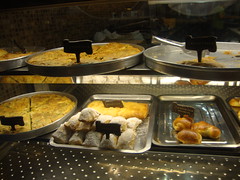
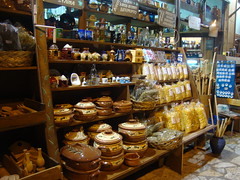

Pies are very popular in the north. Not that a good pita can't be found anywhere in Greece, but they differ from Cretan pastries, for example, which are usually smaller and often fried. For the beans to be bagged in this way means that they were probably grown locally or bought directly from the farmer (many places sell loose beans in Northern/Central Greece). Home-made noodles are a feature of northern Greek cuisine - they are also made in Crete, but less frequently. Other souvenir-type items on display are crockery and kitchen utensils - again, they are food-based.
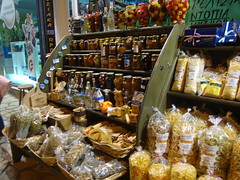
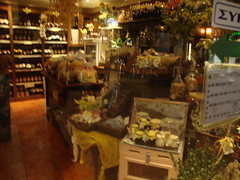
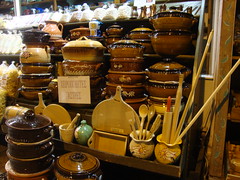
Like any region in Greece, the terrain is used to the best of its ability to grow or raise anything edible. It's not the easiest place to grow Mediterranean plants like tomatoes and aubergines. "Not that it can't be done," Hrisida reminded me; she had shown me her tomato plants which were still green in early September; "it just takes longer". But it's a good place to rear animals for meat. Small farms in the outlying regions supply Karpenisi with high-quality local meat and dairy products, while the rivers provide a range of fish species, including trout. There is no shortage of fish and meat here; what there is a shortage of is fresh fruit and vegetables. "They're more expensive to buy here," Hrisida explained. "We don't produce much in the region given the altitude."
Karpenisi is well known for the typical local produce of a densely forested area: cheese, yoghurt and butter; local meat and cured meats; fruits and nuts growing on trees suited to high altitudes, like cherries, chestnuts, walnuts, berries, black cherries, crab apples and figs. Noodles and pasta are made here according to local customs. Honey (especially fir tree honey, which is only produced every second year) and honey-based products like royal jelly are also a feature of wooded regions, as are tsipouro-based liqueurs (made using the 'raki' produced in the area) flavoured with local berries and fruit. My whole family noticed the difference in the taste of the meat in the regions of Central Greece that we toured - let's just say it was some of the tastiest meat we have ever eaten. Specialties of Karpenisi include include meat and cheese dishes. (Hrisida noted at this point that she's tired of it and would prefer some tasty Cretan vegetables.) There's more pasture land available here, whereas in Crete, animals are fed on less natural food, with more processed animal feed.
"That's a tricky one. Are pites part of the Mediterrenean diet? Is Italian pasta part of it too? Pites are the equivalent of lasagne and pitsa, although they relate more to the Balkans and Turkey. We don't do paximadia, which shows that northerners probably baked bread more frequently. So up north there's an emphasis on cooking with dough either as a pita or home-made pasta. The Pontiacs especially do a lot of fresh home-made pasta, which they boil like the Turks. We do trahana and pites, as well as hilopites (χυλοπιτες), also known as 'yiofkades' - γιοφκάδες in Macedonia and Thrace, as well as Turkey, what FYR Macedonia calls 'yufki*', which is dried pasta. In the Peloponnese and the islands, they seem to do a lot of frying, even dough in little morsels, like xerotigana and kalitsounia because of the vast amounts of olive oil there. In mainland Greece they used to have more wheat and flour available to them than in southern Greece. So we can say it's more of a flour-based diet. That goes also for more flour-based Turkish-influenced desserts like ravani, baklava and galaktoboureko, and a lot of baking like koulourakia (biscuits) and tsourekia (sweet loaves). Of course the north used to use more animal fats like pork fat and butter, but this isn't the case now."
Hrisida recalls that on her last visit to Crete, she came across tsigariasto, lamb or goat meat cooked purely in olive oil, as if it'sfried. "That was quite a novelty for us, meat cooked in so much olive oil, instead of being baked, stewed or roasted. Frying is a quick cooking method that doesn't use up much firewood, which was very scarce in Crete compared with mainland Greece. Antikristo is also a very primitive form of cooking, not wanting to waste any heat. You might see more slow-cooked dishes in mainland Greece with thick sauces. But northerners also rely on pulses, vegetables, fish and fruits."
Greek regional cuisine has less to divide it than it does to unite it. In modern times, the different products of the different regions of Greece are now being produced on a more centralised basis, so that each region concentrates on what it does best. While each regional range is distributed in various parts of the country, problems still remain: certain products are produced in small quantities, so there is not enough to go round (eg feta and sausages from Karpenisi: Hrisida says: "If anyone tries to sell you 'genuine feta Karpenissiou' outside the region, they're probably not telling you the truth; there isn't enough to go round, even for our own needs'), while other products (eg mizithra from Crete) are highly perishable and do not travel well. But regionalism in food is a valued trait, so Greeks in the rural regions continue to prepare, cook and eat their 'own' food, because that's what they've grown up with, that's what they like to eat, and most importantly, that's what's fresh, local and seasonal where they live, supplementing any restrictions with products from other areas of Greece.
We were lucky to have good weather while we were in Karpenisi. Hrisida had told me to bring warm clothes for everyone, which I duly did, but they really weren't necessary. "At this time last year, it was raining continuously for a fortnight, so I didn't want to risk it with you," she said. The cafes were full of young people enjoying the unusually warm air of a Karpenisi evening, giving off an atmosphere of gaiety, akin to the entertainment value of the Venetian port in Hania. "Don't put ideas in your head," Hrisida said, "it's not like this all the time. If there's a breeze blowing, it gets frosty and everyone stays indoors. The place closes down by ten on such nights." I found that hard to believe, but maybe we were just very lucky.
* One of my former students from FYR Macedonia has sent me photos showing how these are made: the women all get together in her village and they make hundreds of them at the end of summer when fresh milk and eggs are plentiful. They shape the dough into flat pites and they dry them in an outhouse. They repeat the process in other people's houses until all the women have their supply of yufki. When they want to eat them, they break them up, so it's essentially like pasta - they also use them both fried and boiled in the same dish.
©All Rights Reserved/Organically cooked. No part of this blog may be reproduced and/or copied by any means without prior consent from Maria Verivaki.
Our first night in Karpenisi was spent in the town with Hrisida and her family, who treated us to some freshly baked zimaropita and then took us out for dinner at the local taverna. There is a limited range of dining options in the town itself, but there are many places to choose from if one includes the outlying villages. It was quite late so we decided to stay in the town. The church bells were ringing in joyous mode that evening. People were dressed in their best clothes, all waiting by the main church in the town for the procession of the icon of the Virgin Mary, which was about to take place on the main roads. The church is dedicated to the Birth of the Virgin Mary, which is honoured on September 8th, with vespers always being held on the eve of a feast.
Greece is a well known destination for religious tourism. There are many monasteries and churches with a very touristy reputation on both the mainland and the islands. The video and photos show a typical procession when an icon is taken out of the church and paraded around the main streets of a town. Bear in mind that Karpenisi is located near an important monastery, hence the monk (no, he's not one of Harry Potter's elevation teachers).
"Get used to the dings dongs," Hrisida warned me. "Church bells ring here on a regular basis. We're used to their clanging. Don't forget, there are a number of monasteries near the town."
Karpenisi is an unusual town, both in landscape and population: there are many young people in the area from the TEI (state technological institute) located here, civil servants and old-age pensioners. The Velouchi ski resort provides the town with its main tourist input. Karpenisi, and indeed the whole of the prefecture of Evritania, holds a significant place in Greek history, due to the many heroes of the Greek revolution coming from here, as well as many significant historical events taking place within the area.
Karpenisi in the summer and winter
Karpenisi is small and quite centralised in its structure. The weather is much cooler here than other urban centres in Greece, naturally because of its altitude. There are two main commercial roads in the town, both converging at the main square, and both built on a steep incline. The whole area is surrounded by dense forested mountains. Many high-rise apartments can be seen dotting the hill, but such constructions have now been halted by law, given the nature value of the area; these developments did not pair well with the landscape. In the summer, the climate remains quite cool in the mornings and evenings, heating up during the day. In the winter, snow may cover the ground for days on end. Being used to walking barefoot, I found the floor tiles in Hrisida's house very cold; in Hania, even the floor is warm throughout the summer months.
Karpenisi became a centre of enlightenment with its unique School of Karpenisi. Karpenisi continued to have a high school, which was something to be revered in the early 20th century, as few Greek villages had anything more than a primary school. Striving to educate one's children to give them a better start in life has always held an important place in Greek people's minds and hearts. This accounts for the high education level of the Karpenisiotes, and one of the reasons why they often ended up in government jobs.
Karpenisi isn't the kind of place you go to stay at: it's a good place to base yourself to explore an area of Greece that is not touristy at all. In fact, it's one of Greece's best-kept secrets in terms of off-the-beaten-track places to visit. Hiking, mountaineering, skiing, mushroom foraging, game hunting: they are only a few of the outdoor activities you can enjoy in the area. Every activity has its season too, so that the area is visited all year round. The roads leading in and out of the town all lead to protected villages, stunning scenery, beautiful landscape and nature trails.
During our stroll in the town, I also noticed a good number of food stores. Each place proudly displayed their fresh-looking wares in the windows. This is a sign that people are very interested in what they eat here, and they probably continue the food traditions learnt from their mother's kitchen.



Pies are very popular in the north. Not that a good pita can't be found anywhere in Greece, but they differ from Cretan pastries, for example, which are usually smaller and often fried. For the beans to be bagged in this way means that they were probably grown locally or bought directly from the farmer (many places sell loose beans in Northern/Central Greece). Home-made noodles are a feature of northern Greek cuisine - they are also made in Crete, but less frequently. Other souvenir-type items on display are crockery and kitchen utensils - again, they are food-based.



Like any region in Greece, the terrain is used to the best of its ability to grow or raise anything edible. It's not the easiest place to grow Mediterranean plants like tomatoes and aubergines. "Not that it can't be done," Hrisida reminded me; she had shown me her tomato plants which were still green in early September; "it just takes longer". But it's a good place to rear animals for meat. Small farms in the outlying regions supply Karpenisi with high-quality local meat and dairy products, while the rivers provide a range of fish species, including trout. There is no shortage of fish and meat here; what there is a shortage of is fresh fruit and vegetables. "They're more expensive to buy here," Hrisida explained. "We don't produce much in the region given the altitude."
They took a while to redden, but Hrisida informs me that she did get a good crop of tomatoes this summer.
Sasauges, feta cheese and pies (milk pie, greens pie, pumpkin pie and leek pie); local products and local tastes, representing Karpenisi. The cheeses bear no resemblance whatsoever to any of the Cretan cheeses we buy.

During the meal, I asked Hrisida what she thought about the differences in Greek cuisine among the different regions of Greece. I found that wherever we went, there was a huge emphasis on the local and seasonal, but what it consists of changed as
we went from south to north, as do the colours and flavours and textures of the food. So, would it be true that the cooking of northern Greece is less Mediterranean in style, while keeping with the tradition
of the emphasis of Greek cuisine on the fresh, local and seasonal?
"That's a tricky one. Are pites part of the Mediterrenean diet? Is Italian pasta part of it too? Pites are the equivalent of lasagne and pitsa, although they relate more to the Balkans and Turkey. We don't do paximadia, which shows that northerners probably baked bread more frequently. So up north there's an emphasis on cooking with dough either as a pita or home-made pasta. The Pontiacs especially do a lot of fresh home-made pasta, which they boil like the Turks. We do trahana and pites, as well as hilopites (χυλοπιτες), also known as 'yiofkades' - γιοφκάδες in Macedonia and Thrace, as well as Turkey, what FYR Macedonia calls 'yufki*', which is dried pasta. In the Peloponnese and the islands, they seem to do a lot of frying, even dough in little morsels, like xerotigana and kalitsounia because of the vast amounts of olive oil there. In mainland Greece they used to have more wheat and flour available to them than in southern Greece. So we can say it's more of a flour-based diet. That goes also for more flour-based Turkish-influenced desserts like ravani, baklava and galaktoboureko, and a lot of baking like koulourakia (biscuits) and tsourekia (sweet loaves). Of course the north used to use more animal fats like pork fat and butter, but this isn't the case now."
Hrisida recalls that on her last visit to Crete, she came across tsigariasto, lamb or goat meat cooked purely in olive oil, as if it'sfried. "That was quite a novelty for us, meat cooked in so much olive oil, instead of being baked, stewed or roasted. Frying is a quick cooking method that doesn't use up much firewood, which was very scarce in Crete compared with mainland Greece. Antikristo is also a very primitive form of cooking, not wanting to waste any heat. You might see more slow-cooked dishes in mainland Greece with thick sauces. But northerners also rely on pulses, vegetables, fish and fruits."
Left: Hrisida's harvests in Karpenisi. Right: Maria's harvests in Hania. Apart from potatoes and onions (not pictured), Hrisida also grows corn, which she also gets ground to make cornmeal. The colours, flavours and textures of the local produce of each region in Greece are different, but the emphasis is always on the fresh, local and seasonal.
Greek regional cuisine has less to divide it than it does to unite it. In modern times, the different products of the different regions of Greece are now being produced on a more centralised basis, so that each region concentrates on what it does best. While each regional range is distributed in various parts of the country, problems still remain: certain products are produced in small quantities, so there is not enough to go round (eg feta and sausages from Karpenisi: Hrisida says: "If anyone tries to sell you 'genuine feta Karpenissiou' outside the region, they're probably not telling you the truth; there isn't enough to go round, even for our own needs'), while other products (eg mizithra from Crete) are highly perishable and do not travel well. But regionalism in food is a valued trait, so Greeks in the rural regions continue to prepare, cook and eat their 'own' food, because that's what they've grown up with, that's what they like to eat, and most importantly, that's what's fresh, local and seasonal where they live, supplementing any restrictions with products from other areas of Greece.
We were lucky to have good weather while we were in Karpenisi. Hrisida had told me to bring warm clothes for everyone, which I duly did, but they really weren't necessary. "At this time last year, it was raining continuously for a fortnight, so I didn't want to risk it with you," she said. The cafes were full of young people enjoying the unusually warm air of a Karpenisi evening, giving off an atmosphere of gaiety, akin to the entertainment value of the Venetian port in Hania. "Don't put ideas in your head," Hrisida said, "it's not like this all the time. If there's a breeze blowing, it gets frosty and everyone stays indoors. The place closes down by ten on such nights." I found that hard to believe, but maybe we were just very lucky.
* One of my former students from FYR Macedonia has sent me photos showing how these are made: the women all get together in her village and they make hundreds of them at the end of summer when fresh milk and eggs are plentiful. They shape the dough into flat pites and they dry them in an outhouse. They repeat the process in other people's houses until all the women have their supply of yufki. When they want to eat them, they break them up, so it's essentially like pasta - they also use them both fried and boiled in the same dish.
©All Rights Reserved/Organically cooked. No part of this blog may be reproduced and/or copied by any means without prior consent from Maria Verivaki.






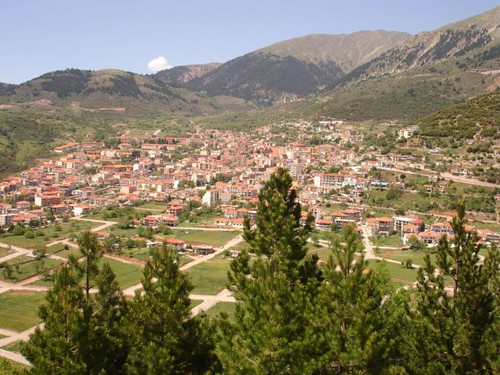

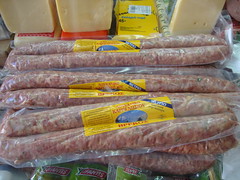
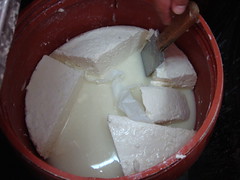
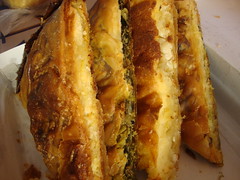
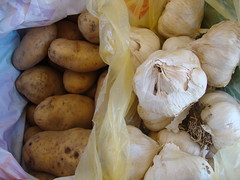
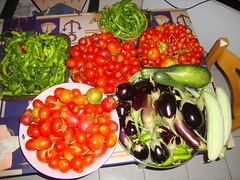
No comments:
Post a Comment